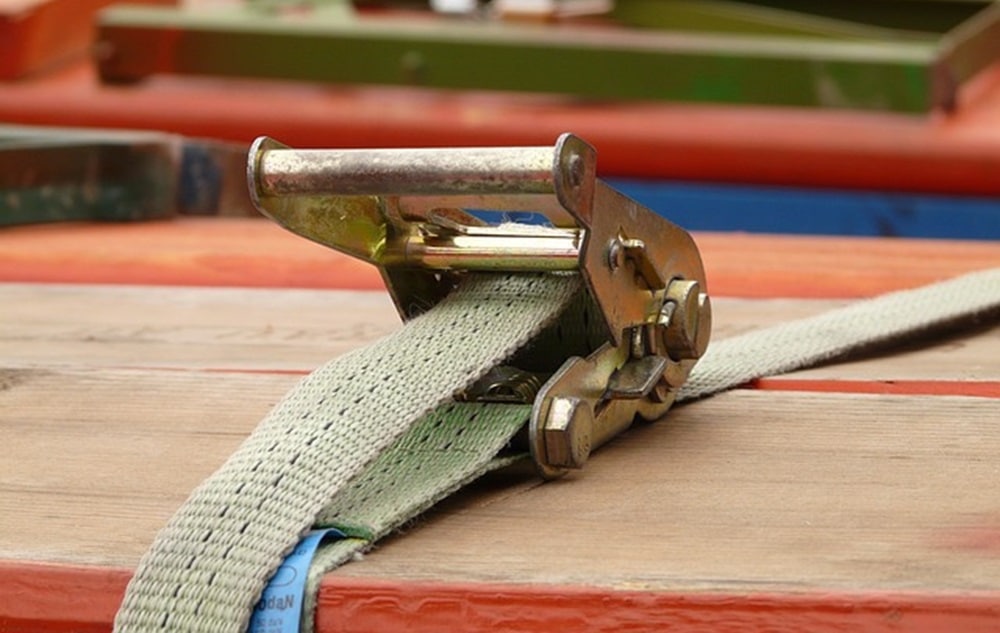PR News
3 Safety Tips to Keep In Mind When Using Ratchet Straps for the First Time

If you have to move anything from your ATV to some furniture from point A to point B then you may have invested in a few tie down straps. As one of the most effective methods to secure cargo, tie downs are a must to safely transport your items.
More commonly known as ratchet straps, tie downs will go a long way to ensuring that your goods don’t fall off the trailer or flatbed truck they’re being transported on. It’s important to point out that there are several safety considerations that you should consider if you’re using ratchet straps for the first time.
Proper and Safe use Should be Top Priority
It’s not uncommon to see Australians transporting their own goods when they’re moving or simply taking the ATV for a spin on the trails. That said, there’s a little more to safely using a ratchet strap than simply clicking it in place around your cargo. Our team of experts have compiled a list of the top safety tips to consider if you’re using your tie down straps for the first time.
Select the Best Ratchet Straps
Not all ratchet straps are the same. That means you should consider certain aspects of the cargo you’re going to move before just opting for any type of strap. When choosing the right ratchet strap for the job, keep the following in mind:
- Capacity: The capacity of a ratchet strap refers to the cargo weight that the strap will have to hold. For instance, the strap that holds your ATV on the back of your trailer will be considerably stronger than the one you might use to hold a coffee table. If you aren’t sure, always overestimate the weight to be on the safe side.
- Length: Straps should always fit comfortably over your cargo and reach the sides of your trailer. There shouldn’t be any strain or pieces that you join with other ropes or straps. Keep in mind that this will cause tension and may result in the strap snapping mid-travel.
- Hooks: As with different types of straps, there are also a variety of hooks that are connected to the straps. It’s important to purchase the right hooks for the type and capacity of ratchet straps being used.
Correct Use is Key
This may sound like common sense, but our experts have seen instances where careless individuals have simply tied straps together, foregoing the use of hooks altogether! Not only is this extremely dangerous as your cargo isn’t 100% secure, but you’re also compromising the strap for future use.
Rather follow these simple steps to ensure that your ratchet straps are securely fastened:
- Step 1: Inspect the straps you’re going to use to ensure that there are no tears, loose fibres or other damages to the material or metal casing and locking mechanism.
- Step 2: Place the loose end of the strap into the mandrel (square metal part) of the tie down strap.
- Step 3: Once the strap is threaded safely into the mandrel, pull the strap through the mandrel.
- Step 4: Pull the slack to tighten the strap as tight as possible without straining.
- Step 5: Use the crank on the ratchet strap to securely tighten the strap.
- Step 6: Tug at the strap to test if it’s tightened enough. Avoid tangling, knotting or too much strain on the strap. The strap should be lying safely and securely over the cargo.
- Step 7: Lock the mandrel by pushing the handle downwards.
Storage is as Important
Once you have arrived at your destination, taking the ratchet straps off carefully and correctly storing them is as important as putting them on the right way. This is because incorrect storage can damage your ratchet straps, leaving you with inferior straps.
Consider these tips to keep your tie down straps stored safely:
- Always store ratchet straps in an airtight container, place them on a shelf or hang them against your garage wall. The only real criteria here is that storage is cool and dry and away from the sun. Keep in mind that the sun can weaken the strap material, leading to fraying and damage.
- Avoid any exposure to dampness or moisture as this creates the perfect environment for bacteria and mould growth. Not only do both of these damage the material fibres, but bacteria spores can also rub off on your hands posing a health risk if inhaled. If your straps got wet during a rainy trip, hang the straps up in your garage to dry out before packing them away.
Final Thoughts
Ensuring that you use your ratchet straps safely should be a top priority when you’re tying your cargo. This rule should apply whether you’re transporting a small item a few streets away, or your ATV across the country. Double-checking the straps should also feature high on your pre-transport checklist before you head out. Doing this will ensure that your cargo doesn’t put you and other drivers at risk.
People Also Reading:
3 Additional Services to Consider When Hiring a Mobile Crane for Your Project Requirements
3 Additional Services to Consider When Hiring a Mobile Crane for Your Project Requirements
PR News
The Impact of the 2024 IRS Mileage Rate on Small Businesses

The IRS mileage rate 2024 stands as a pivotal benchmark for small businesses, marking not just a figure on a tax form but a crucial factor influencing their financial strategies and daily operational decisions.
This rate, set at 67 cents per mile for business travel, reflects not only the cost of fuel and vehicle maintenance but also broader economic trends and regulatory shifts that impact businesses of all sizes.
For small businesses, where every expense matters, the IRS mileage rate directly affects how they allocate resources. It shapes budgeting decisions, tax planning strategies, and even employee compensation policies.
Understanding and effectively applying this rate can mean the difference between maximizing tax deductions and facing unexpected financial liabilities. Moreover, the IRS mileage rate serves as a barometer for economic conditions affecting transportation costs.
Changes in this rate can prompt businesses to reassess their logistics and supply chain strategies, explore alternative modes of transportation, or renegotiate contracts with service providers. Thus, the rate extends beyond a mere tax calculation, becoming a catalyst for strategic adaptation and operational efficiency.
The 2024 IRS mileage rate is not just a number—it’s a critical factor that small businesses must navigate strategically to optimize financial performance and maintain compliance with tax regulations.
A crucial adjustment for small businesses impacting various aspects
The 2024 IRS mileage rate plays a pivotal role in shaping financial strategies and operational efficiencies for small businesses. Adapting to these changes proactively can help businesses navigate challenges, optimize tax benefits, and maintain competitive advantages in their respective markets.
Cost Management and Budgeting: Small businesses often rely on accurate mileage tracking to calculate transportation costs. The updated IRS rate affects budgeting forecasts, requiring adjustments to financial plans to accommodate higher mileage expenses.
Tax Deductions and Reimbursements: The IRS mileage rate directly affects tax deductions and reimbursements for business-related driving. Small businesses can deduct eligible mileage expenses from their taxable income, reducing their overall tax liability. Therefore, understanding and correctly applying the updated rate is crucial for maximizing tax benefits.
Employee Compensation: For businesses that reimburse employees for mileage, the IRS rate serves as a benchmark. Compliance with the standard rate ensures fair reimbursement practices while simplifying administrative tasks related to expense reporting.
Strategic Decision-Making: Changes in the IRS mileage rate prompt strategic evaluations regarding transportation logistics. Businesses may reconsider vehicle leasing versus reimbursement policies or explore alternative transportation methods to optimize cost-efficiency.
Compliance and Documentation: Accurate record-keeping is essential for IRS compliance. Small businesses must maintain detailed logs of business miles driven and associated expenses to substantiate deductions during audits. Failure to adhere to IRS guidelines can result in penalties and additional scrutiny.
Impact on Profit Margins: Fluctuations in mileage rates directly influence profitability margins for businesses heavily reliant on transportation. The increased rate may squeeze profit margins unless offset by corresponding adjustments in pricing or operational efficiencies.
Operational Efficiency: Efficient mileage tracking and management systems become more critical with higher IRS rates. Adopting digital tools or mileage tracking apps can streamline reporting processes, ensuring compliance while reducing administrative burden.
Everlance as a tool to facilitate compliance with the IRS mileage rate
Everlance serves as a robust tool to streamline compliance with IRS regulations, particularly regarding mileage tracking and reporting for small businesses.
Automated mileage tracking
Everlance provides a sophisticated solution for automated mileage tracking, which greatly simplifies the process of documenting business trips. This feature allows users to accurately record each drive and link it to relevant business activities, ensuring the accuracy and reliability of data required for IRS reporting.
Integration with IRS standards
Everlance is designed to easily integrate with IRS standards, including the latest mileage reimbursement rate. Users can easily monitor rate changes and automatically apply updated rates to their rides, ensuring compliance with the latest regulations and maximizing tax returns.
Using the Everlance platform allows small businesses to effectively manage their driving expenses while ensuring they are in compliance with IRS requirements without significant administrative effort.
Related News:
The Main US Inflation Tracker Increased For The First Time
Trudeau’s Gun Grab Could Cost Taxpayers a Whopping $7 Billion
PR News
Why ICTCRM Open Source CRM is the All-in-One Solution Your Business Needs for Seamless Customer Communication and Engagement

In today’s fast-paced business environment, seamless customer communication and engagement are critical for success. Businesses are seeking solutions that not only help manage customer relationships but also facilitate communication across multiple channels. The solution? ICTCRM, a powerful open-source CRM Software that integrates the advanced features of ICTContact and SuiteCRM to offer a unified communication CRM system.
Whether you’re running a small business or managing a large enterprise, ICTCRM provides the tools necessary to build stronger relationships with customers, enhance internal and external communication, and streamline operations.
This article explores why ICTCRM is the all-in-one solution for modern businesses, diving into its unique features, integration capabilities, and how it helps organizations achieve seamless customer engagement. We’ll also highlight the core contact center functionalities that elevate this CRM beyond traditional systems.
1. What Is ICTCRM?
ICTCRM is an advanced, open-source CRM system that combines the capabilities of customer relationship management and unified communications. Developed with a focus on flexibility and scalability, it integrates ICTContact, a robust multi-tenant contact center software, and SuiteCRM, one of the most popular open-source CRMs.
This integration offers a complete solution that supports customer communication through multiple channels like email, phone, SMS, and social media, while also providing the rich functionality of a CRM platform to manage sales, marketing, customer support, and more.
2. Why Choose ICTCRM for Your Business?
There are plenty of CRM solutions on the market, but ICTCRM stands out for several reasons:
- Open Source and Cost-Effective: Being open-source, ICTCRM eliminates expensive licensing fees that come with many proprietary systems, making it a cost-effective solution for businesses of all sizes.
- Comprehensive Feature Set: ICTCRM is not just a CRM; it’s a unified communication platform that integrates telephony, email, SMS, and other communication channels within the CRM system. This means you can manage all customer interactions from a single platform.
- Scalability and Flexibility: Built with scalability in mind, ICTCRM can handle the needs of small startups and large enterprises alike. It is customizable and can adapt to the specific workflows and processes of any business.
- Integration with ICTContact: The integration with ICTContact brings powerful contact center features like auto-dialing, call scheduling, IVR, campaign management, and more to the CRM environment, making it ideal for businesses with a strong focus on communication.
3. Main Features of ICTCRM
ICTCRM offers a wide range of features that cater to various aspects of customer relationship management and unified communications. Let’s take a closer look at some of its key features.
a. Unified Communication Integration
One of the standout features of ICTCRM is its ability to integrate multiple communication channels within the CRM system. Businesses no longer need separate tools for handling calls, emails, SMS, or social media messages. ICTCRM unifies all of these into a single interface, allowing users to:
- Manage Calls and Messages: Make and receive calls, send SMS messages, and track emails directly from the CRM interface.
- Automate Communication: Automate follow-up messages, appointment reminders, and marketing campaigns through voice, SMS, or email channels.
- Omnichannel Customer Support: Deliver superior customer service by responding to customers across different communication channels, all managed within the CRM.
b. Contact Management
Managing customer information is at the heart of any CRM system, and ICTCRM excels in this area:
- Complete Customer Profiles: ICTCRM enables businesses to maintain comprehensive customer profiles, tracking all interactions, preferences, and communication history in one place.
- Segmentation: Segment contacts into specific groups based on demographics, behavior, or interaction history, enabling personalized communication strategies.
c. Sales Automation
For sales teams, ICTCRM offers tools that streamline the sales process and automate tasks that would otherwise be time-consuming:
- Pipeline Management: Visualize and manage your sales pipeline, tracking every deal from initial contact to closure.
- Lead Management: Track, nurture, and convert leads with automated follow-ups, ensuring no opportunity falls through the cracks.
- Task Automation: Automate repetitive tasks like sending reminders, updating records, or generating follow-up emails to enhance productivity.
d. Marketing Campaigns
ICTCRM provides robust marketing capabilities that allow businesses to create and execute marketing campaigns directly from the CRM:
- Email and SMS Campaigns: Create personalized email and SMS campaigns, track responses, and manage leads.
- Multi-Channel Marketing: Utilize a multi-channel approach to reach customers through different touchpoints (email, SMS, calls, etc.).
- Analytics and Reporting: Track the performance of your marketing campaigns with built-in analytics and reporting tools.
e. Workflow Automation
Efficiency is key to business success, and ICTCRM’s workflow automation helps eliminate manual processes:
- Automate Business Processes: Create automated workflows for tasks like lead routing, case assignment, or approval processes.
- Custom Workflows: Build custom workflows that match your business processes, allowing you to automate repetitive tasks and focus on high-value activities.
4. Contact Center Features
A key differentiator of ICTCRM is its integration with ICTContact, which turns it into a powerful tool for managing contact center operations. Businesses that require advanced communication capabilities will benefit greatly from this integration. Here are some standout contact center features:
a. Auto Dialer
This feature is invaluable for sales teams, customer service departments, and businesses running marketing campaigns. The auto dialer allows:
- Predictive and Progressive Dialing: Dial multiple numbers simultaneously, connecting agents only to answered calls, increasing efficiency.
- Automated Voice Campaigns: Schedule and automate voice campaigns to broadcast pre-recorded messages to a large number of customers.
b. IVR (Interactive Voice Response)
The IVR feature allows businesses to automate call handling, guiding customers through a series of voice prompts to route them to the correct department or provide self-service options. This feature can:
- Improve Customer Service: Reduce wait times and enhance customer satisfaction by enabling customers to resolve queries without speaking to an agent.
- Customization: Businesses can customize IVR scripts based on their specific needs and update them easily through the CRM interface.
c. Campaign Management
- Multi-Channel Campaigns: Run campaigns across different channels (phone, email, SMS), managing them all from the CRM.
- Campaign Scheduling: Schedule campaigns for specific dates and times, ensuring optimal reach and engagement with your target audience.
d. Call Recording and Monitoring
Call recording and monitoring are essential for businesses that want to maintain quality control and ensure compliance. With ICTCRM, you can:
- Record Calls: Automatically record calls and store them for future reference or training purposes.
- Monitor Live Calls: Supervisors can monitor live calls in real-time, ensuring agents are adhering to best practices and providing top-notch customer service.
e. Reporting and Analytics
Contact centers require detailed reporting to track performance and identify areas for improvement. ICTCRM offers a comprehensive set of reporting and analytics tools, allowing businesses to:
- Track Key Metrics: Measure call volume, agent performance, response times, and customer satisfaction.
- Campaign Analytics: Analyze the effectiveness of marketing and communication campaigns through detailed reports that provide actionable insights.
5. Customization and Flexibility
ICTCRM is highly customizable, making it easy for businesses to adapt the platform to their unique workflows and requirements. Some customization options include:
- Custom Modules: Add or modify modules to suit specific business processes.
- Custom Dashboards: Create custom dashboards that display key performance indicators (KPIs) and real-time data.
- APIs and Integration: ICTCRM offers REST APIs for easy integration with other third-party systems and tools.
Conclusion: The All-in-One Solution for Modern Business Needs
ICTCRM is more than just a traditional CRM. Its integration with ICTContact and SuiteCRM transforms it into a unified communication CRM platform, allowing businesses to manage every aspect of customer relationships and communication from one place. Whether it’s sales automation, marketing campaigns, customer service, or contact center management, ICTCRM has all the tools needed for success.
By choosing ICTCRM, businesses can streamline operations, enhance customer engagement, and stay ahead in a competitive marketplace. Its open-source nature, combined with its comprehensive feature set and flexibility, makes it the ideal solution for businesses looking to take their customer communication to the next level.
In a world where customer expectations are rising, ICTCRM provides the tools to meet those demands while also helping businesses grow and thrive.
Related News:
Apple Launches The iPhone Into The AI Era With Free Software Update
Google Releases Software That Stamps Text Generated By Artificial Intelligence.
PR News
ICTDialer Transforming Businesses With Cloud-Based Call Center Solutions

Discover How ICTDialer Can Transform Your Business
In today’s fast-paced business environment, communication plays a pivotal role in driving customer satisfaction, operational efficiency, and overall success. For organizations looking to elevate their customer service operations, cloud-based call center solutions offer a flexible, scalable, and cost-effective alternative to traditional on-premise setups.
Among the various options available in the market, ICTDialer stands out as a powerful, cloud-based solution designed to revolutionize your call center operations.
Whether you’re a small business looking to scale up or an established enterprise seeking more advanced features, ICTDialer provides a comprehensive suite of tools that can transform how your team interacts with customers. This article will delve into the key features of ICTDialer, showcasing how its capabilities can optimize your call center processes, improve customer interactions, and help you stay competitive in today’s digital age.
What is ICTDialer?
ICTDialer is a robust, cloud-based call center platform designed to streamline communication processes and improve the efficiency of inbound and outbound calls. It provides a flexible, scalable solution for businesses of all sizes, helping them reduce operational costs while enhancing customer experience. With its advanced features and easy integration capabilities, ICTDialer is tailored to meet the diverse needs of modern businesses, from small startups to large enterprises.
Why Choose a Cloud-Based Call Center?
Before we dive into the specific features of ICTDialer, let’s quickly review why cloud-based call center solutions have become the preferred choice for businesses worldwide:
- Scalability: Cloud-based systems allow you to scale your call center operations up or down based on your business needs. This flexibility ensures that you only pay for what you need, making cloud call centers cost-effective.
- Remote Accessibility: Cloud call centers can be accessed from anywhere, allowing your agents to work from multiple locations, which is particularly valuable for businesses with remote or distributed teams.
- Advanced Features: Cloud platforms like ICTDialer offer a wide range of features such as AI-powered analytics, real-time monitoring, and automatic call distribution, which are often difficult to implement in on-premise systems.
- Cost Efficiency: Traditional call centers often require significant investments in infrastructure, hardware, and maintenance. With cloud-based solutions, businesses can avoid these upfront costs and ongoing maintenance expenses.
Now that we understand the benefits of cloud-based call centers, let’s explore how ICTDialer can help your business succeed.
Key Features of ICTDialer
1. Automatic Call Distribution (ACD)
ICTDialer’s Automatic Call Distribution (ACD) system ensures that calls are routed to the right agent quickly and efficiently. With intelligent call routing, the system can direct calls based on factors such as agent availability, skills, and priority levels. This ensures that customers receive prompt and appropriate service, improving satisfaction rates and reducing call waiting times.
- Skill-based Routing: Calls are routed to agents with the specific skills required to address the customer’s needs, ensuring faster resolution and better customer experience.
- Priority-based Routing: Calls can be prioritized based on customer data, ensuring that high-value clients or urgent issues are addressed first.
2. Predictive Dialer
ICTDialer’s predictive dialer technology significantly enhances outbound calling campaigns. By automatically dialing numbers and connecting agents only when a live person picks up, the predictive dialer maximizes agent productivity and reduces downtime. It also reduces the likelihood of dropped calls, which can negatively impact customer experience.
- Increased Agent Productivity: With automatic dialing, agents spend less time manually dialing numbers and more time engaging with customers.
- Improved Call Connect Rate: The system ensures that agents are only connected to answered calls, eliminating wasted time on unanswered or busy lines.
3. Interactive Voice Response (IVR)
ICTDialer includes an advanced IVR studio system that can handle routine customer inquiries and efficiently direct calls to the right department or agent. IVR systems reduce the workload on agents by automating simple tasks, such as providing business hours, processing account balances, or answering frequently asked questions.
- Personalized Customer Experience: ICTDialer’s IVR system can be customized to offer a more personalized experience, greeting callers by name or directing them based on past interactions.
- Self-service Capabilities: By providing customers with self-service options, the IVR reduces call volume and improves customer satisfaction.
4. Real-Time Reporting and Analytics
ICTDialer provides real-time reporting and analytics tools that allow call center managers to monitor agent performance, track key performance indicators (KPIs), and make data-driven decisions. The system provides in-depth insights into call volume, agent productivity, customer satisfaction, and more.
- Customizable Dashboards: Managers can create dashboards tailored to their specific needs, providing them with the most relevant information at a glance.
- Actionable Insights: The analytics tools help identify trends, bottlenecks, and areas for improvement, enabling businesses to optimize their operations continuously.
5. CRM Integration
ICTDialer integrates seamlessly with customer relationship management (CRM) systems, allowing agents to access customer data and interaction history in real time. This integration helps agents provide more informed and personalized support, improving first-call resolution rates and overall customer experience.
- Centralized Customer Data: By having all customer information in one place, agents can quickly resolve issues and avoid repetitive interactions.
- Enhanced Customer Insights: Access to detailed customer profiles allows agents to anticipate needs and deliver more tailored solutions.
6. Call Monitoring and Coaching
With ICTDialer, call center supervisors can monitor live calls, listen to conversations, and provide real-time coaching to agents. This feature helps improve agent performance, ensures adherence to quality standards, and enhances training.
- Whisper Coaching: Supervisors can coach agents during live calls without the customer hearing, providing guidance and feedback in real time.
- Call Barging: Supervisors can join active calls when necessary, ensuring that critical issues are handled appropriately.
7. Call Recording
ICTDialer includes call recording capabilities, allowing businesses to record conversations for training, compliance, and quality assurance purposes. These recordings can be accessed on-demand, providing valuable insights into agent performance and customer feedback.
- Compliance and Training: Call recordings ensure that businesses meet regulatory requirements and provide a resource for ongoing employee training and development.
- Quality Assurance: Recorded calls can be reviewed to assess the quality of customer interactions and identify areas for improvement.
8. Scalability and Flexibility
One of the major advantages of ICTDialer is its scalability. As a cloud-based solution, ICTDialer can grow with your business, allowing you to add new agents or features as needed without the need for expensive hardware upgrades or complex installations.
- Scale with Ease: Adding new agents or expanding to new locations is a breeze, as the platform can support businesses of all sizes.
- Customizable Solutions: ICTDialer offers a range of customization options, allowing businesses to tailor the platform to their specific needs and workflows.
Benefits of Using ICTDialer
- Cost Savings: By eliminating the need for expensive on-premise infrastructure and reducing operational costs, ICTDialer helps businesses save money while still offering advanced call center features.
- Improved Customer Satisfaction: The ability to provide faster, more personalized service leads to higher customer satisfaction and loyalty.
- Increased Productivity: Automation features like the predictive dialer, ACD, and IVR help maximize agent productivity, allowing businesses to handle more calls with fewer resources.
- Data-Driven Decisions: With real-time analytics and reporting, businesses can make informed decisions to optimize their call center operations and improve performance.
Conclusion
In conclusion, if you’re seeking a cloud-based call center solution that offers advanced features, scalability, and cost efficiency, ICTDialer is an excellent choice. Its powerful suite of tools—from predictive dialing to real-time reporting—can transform your call center operations, helping you deliver exceptional customer service while improving productivity and reducing costs.
With ICTDialer, you’re not just adopting a call center platform—you’re embracing the future of communication, one that is flexible, secure, and designed to meet the demands of modern businesses. So, if you’re ready to revolutionize your customer service and streamline your operations, ICTDialer is the solution you’ve been searching for.
Related News:
Strong Solar Storm Could Disrupt Communications And Produce Northern Lights In US
Boeing’s First Astronaut Flight Called Off At The Last Minute In Latest Setback
-
Politics3 weeks ago
Miller Expects 4.9 Million Foreigners to Leave Canada Voluntarily
-
News3 weeks ago
Nolinor Boeing 737 Crash Lands in Montreal
-
News2 weeks ago
“Shocking Video” Vancouver Police Shoot Armed Suspect 10 Times
-
Tech3 weeks ago
Increasing its Stake in OpenAI by $1.5 Billion is a Possibility for SoftBank.
-
News4 weeks ago
Facebook Securities Fraud Case Dropped
-
Health4 weeks ago
A Canadian Teenager’s Bird Flu Virus Has Mutations


























